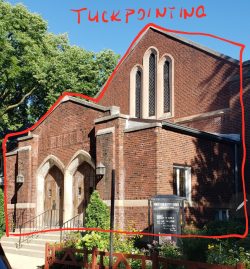The History Of Tuckpointing In Chicago
Uncovering The History of Chicago Tuckpointing
Chicago is a city steeped in history and culture, with a unique construction style. One of the unique components of this style is tuckpointing – an exterior masonry technique that has been used for centuries to provide strength and stability to buildings. Tuckpointing is still prevalent in Chicago today, but its origins date back to the mid-1700s when this technique was first employed in the region.

What is tuckpointing?
Tuckpointing is a specialized repair technique used to repair mortar joints in masonry structures. It involves removing damaged or deteriorated mortar and replacing it with new, strong mortar tinted to match the original appearance.
This ensures that any structural damage caused by the deterioration of the old mortar can be repaired without altering the overall look of the structure.
This type of tuckpointing is particularly common in structures like chimneys, which are exposed to much more significant wear and tear than other parts of the building due to their height and location.
The tuckpointing process begins by grinding out the existing mortar between bricks and other masonry elements using an angle grinder with a diamond blade.
Once the weakened material has been removed, a new mixture of cement, lime, sand and water is applied to fill any gaps left behind. The result is a seamless construction bond that provides strength and longevity for years to come. Tuckpointing also helps protect against water infiltration, which can cause further damage if left unchecked.
Tuckpointing in Chicago
Tuckpointing is integral to keeping Chicago buildings looking their best and protecting them from the elements.
Tuckpointing in Chicago has become increasingly popular due to its ability to preserve historic architecture while protecting against rain, snow, wind, and other environmental factors.
With over 20 years of experience in tuckpointing services in Chicago, our team at Augustyn Tuckpointing & Masonry can help you restore your building’s original beauty while increasing its longevity.
Early Tuckpointing Techniques
The earliest tuckpointing techniques were basic, typically involving straight lines and geometric shapes.
However, as tools such as chisels and mallets became more available, tuckpointers began experimenting with more complex patterns like scrolls and rosettes. In addition to improving their design capabilities, tuckpointers also developed new ways to apply the mortar so that it would adhere better and last longer.
These advances enabled them to produce higher-quality results than ever before
Tuckpointing is a traditional masonry technique dating back to the 1700s. It involves creating a pattern of tiny lines between two different colors of mortar, which gives the appearance of finely cut bricks.
This unique decorative technique has been used for centuries to create stunning focal points on walls and buildings worldwide. The process requires an experienced mason who can precisely place each mortar line and expertly blend the colors to achieve the desired finish.
Early tuckpointing techniques were intricate and labor-intensive, often taking multiple days or weeks to complete one project, depending on its complexity.
Tuckpointing was also used to improve structural integrity in brickwork. Certain lines would be filled with stronger mortar than others to reinforce weak spots or seal up gaps.
The consequences can be severe if a brick home is not tuckpointed.
Without tuckpointing, water can easily seep into these areas, resulting in problems such as structural damage, mold growth and even insect infestation.
That can cause immense damage to the building structure if left unchecked for an extended period of time and will eventually require costly repairs or replacements.
An unattended home will look much less desirable than one regularly maintained with proper care, including regular maintenance such as tuckpointing.
Related: Guide To Hiring A Quality Tuckpointer In Chicago
Modern-Day Tuckpointing Practices
Modern tuckpointing techniques have evolved significantly, allowing masons to work faster and more accurately than ever before.
With technological advancements, materials and tools used for tuckpointing can now be custom-made according to specific requirements, ensuring consistency across projects.
Today, masons use diamond blades on grinders and angle grinders for more precision when removing old mortar from joints.
They can also use power drills with small augurs or bits to help speed up the process of creating uniform joint depths between bricks.
The Nuances Of Tuckpointing
Tuckpointing encompasses a variety of distinct techniques, which I have outlined in the following five points:
Lintels
What is a lintel in Construction
Lintels are horizontal elements that span the top of a doorway, window, or fireplace. They form the upper frame and help to hold up the wall above it. Lintels have been used in Construction for centuries. They come in many materials, such as stone, brick, steel, concrete, and wood. As well as providing support to a building structure, lintels also add an aesthetic appeal to architecture.
Why Are Lintels Important
The primary purpose of lintels is to provide structural support for openings by transferring the load from the roof or floor above onto either side of the opening.
Without lintels, these structures would be too weak and could collapse under pressure or become unstable over time due to their weight distribution.
Related: How Much Does Tuckpointing Cost In Chicago?
Caulking
What is Caulking?
Caulking is a process in which a sealant is used to fill and seal cracks or gaps in various surfaces.
The most commonly caulked materials are wood, metal, plastic, glass, ceramic tile and concrete. The primary purpose of caulking is to prevent air and water from leaking through these spaces.
Caulking helps protect the underlying material from decay by preventing the infiltration of moisture that causes deterioration. In addition to protecting against water damage, caulking can improve energy efficiency by preventing drafts from entering through gaps around windows and doors.
Caulking should be done regularly to maintain effectiveness for as long as possible. Caulking should also be checked for areas where it may have worn away or come loose over time due to natural wear and tear or exposure to extreme temperatures or moisture levels.
Waterproofing
Waterproofing is another essential step in protecting the home from water damage.
It can involve applying sealants, paints, membranes, or other products to protect surfaces against moisture intrusion. Doing so helps keep out rainwater and moisture from humidity and condensation.
Both processes aren’t recommended for DIYers. It’s always best to consult with a qualified expert before tackling significant projects like waterproofing.
In conclusion, tuckpointing has a long and rich history in Chicago and is an essential part of its cultural identity.
From masonry to architecture, tuckpointing has been used to repair and rebuild some of the most iconic structures in the city.
Tuckpointing has been used to restore beautiful buildings while maintaining their original charm and character.
In conclusion, tuckpointing has a long and rich history in Chicago and is an essential part of its cultural identity. From masonry to architecture, tuckpointing has been used to repair and rebuild some of the most iconic structures in the city.
Tuckpointing has been used to restore beautiful buildings while maintaining their original charm and character.
Call us now at (773) 679 -1646 for a free estimate on your tuckpointing needs – time is of the essence!
Related: Don’t Let Tuckpointing Threaten The Strength Of Your Chicago Home



